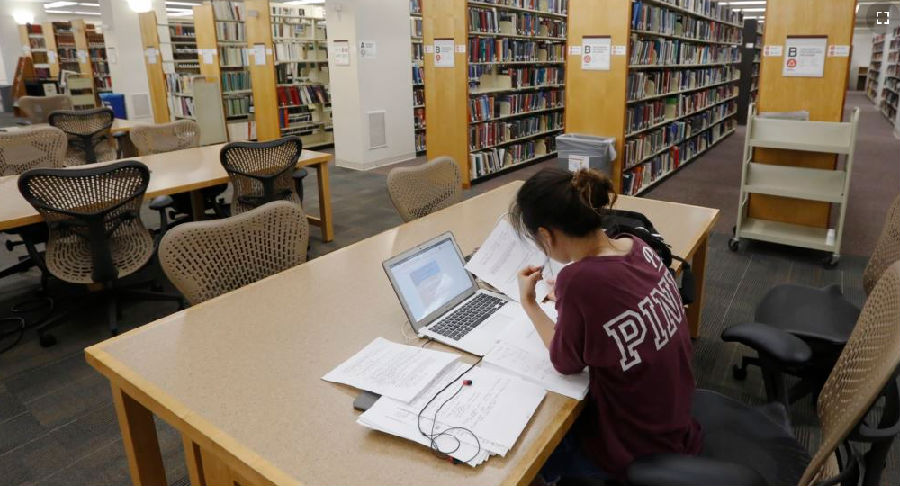US College Leaders Worry About the Future
For generations, the United States has enjoyed one of the strongest higher education systems in the world. But conditions at U.S. colleges and universities are changing, and that system now faces challenges.
Many higher education leaders worry about their ability to deal with a number of issues in the years to come. However, several experts think the schools will do well if they are willing to try new methods of meeting students’ needs.
In October, the American Council on Education reported on a survey of nearly 500 leaders at four-year, non-profit colleges and universities. The study was a joint effort with the Georgia Institute of Technology and the Huron Consulting Group.
The school officials were asked about what they thought would be the biggest issues their institutions would face over the next three to five years. They also were asked how well they thought their college or university would be able to deal with these challenges.
The study identified the top six issues that the 500 leaders listed. The most common concern was increasing competition with other educational institutions. About 62 percent of those questioned noted that concern. The next most common issue was the decreasing size of the traditional student population, meaning students between 18 and 24 years old.
Thirty-nine percent of the leaders listed the growing numbers of non-traditional students, including adults with full-time jobs. Two other concerns were shrinking state and federal financial support, and decreasing public trust in higher education. Also, the officials said they were worried about political conditions around the world, and their effect on international students coming to the United States.
When it comes to changes in the student population, the college and university officials felt like they have some answers. In fact, 89 percent expressed confidence in their school’s ability to meet the needs of the growing number of students who are working adults.
Peter Stokes argues this is because colleges and universities have always been dealing with change. Stokes is the managing director for higher education with Huron.
"We haven’t had any real consistency in … student involvement in higher education, the degrees that are delivered, the industries that are being serviced. So there’s continual change," he told VOA.
Stokes added that after World War II there was a sharp jump in the U.S. birth rate, leading to an increase in the number of young people going to college. Then, after the Great Recession in 2008, the birth rate dropped. Around that time, the number of working adults starting or returning to higher education began rising.
The traditional student population will likely recover eventually, Stokes says. Until then, schools will have to continue on the path many have already started down of using nontraditional methods to deliver higher education. This includes increasing internet-based and short-term programs to meet the needs of students who have less time and money to spend.

As for the five other issues identified in the study, plenty of concerns remain. No more than seven leaders felt very confident in their school’s ability to find solutions to any of the issues.
Louis Soares is the chief learning officer at the American Council on Education. He says that in recent years, Americans have come to think of higher education as more of a means of getting a well-paying job than as a public good.
This may not be surprising given the increased cost of higher education. But Soares says that this put many educational institutions in competition with one another to prove how their programs can affect better career results.
At the same time, U.S-based companies like Amazon and Google are creating their own educational programs to compete with traditional degree programs. And countries like France, Canada and Australia are becoming more appealing to international students who would have likely looked to U.S. schools in the past.
As a result, some colleges and universities across the country have been closing. The U.S. Department of Education reports that in 2018 the number of institutions nationwide dropped to its lowest level since 1998.
Soares suggests that schools have a better chance of surviving if they work together, as Georgia Tech has, sharing new program ideas and methods with 50 other institutions. But that is not always easy.
"U.S. higher education is innovative, but the innovation tends to be small-scale," he said.
Lynn Pasquerella says what might be more important is working on the issues around public trust and governmental support of higher education. And she suggests the two issues are closely connected.
Pasquerella is president of the Association of American Colleges and Universities. She says U.S. higher education has done a poor job of showing that what goes on at an institution is very important. Many people have come to think of colleges and universities as places where students waste time learning unnecessary subjects or hearing one-sided beliefs.
But many students go on to become business and political leaders who shape policies in hopes of improving living conditions in their communities and nationwide. And major scientific and technological developments usually start out in a college or university laboratory.
"Demonstrating the ways in which … their success is inextricably linked to the physical, emotional, economic well-being of people in the communities in which they’re located and which they seek to serve … is a first and critical step in helping to restore public confidence in higher education," noted Pasquerella.
She adds that as Americans develop a better opinion of the schools, state and federal governments will have little choice but to support them.
I’m Dorothy Gundy. And I’m Pete Musto.











